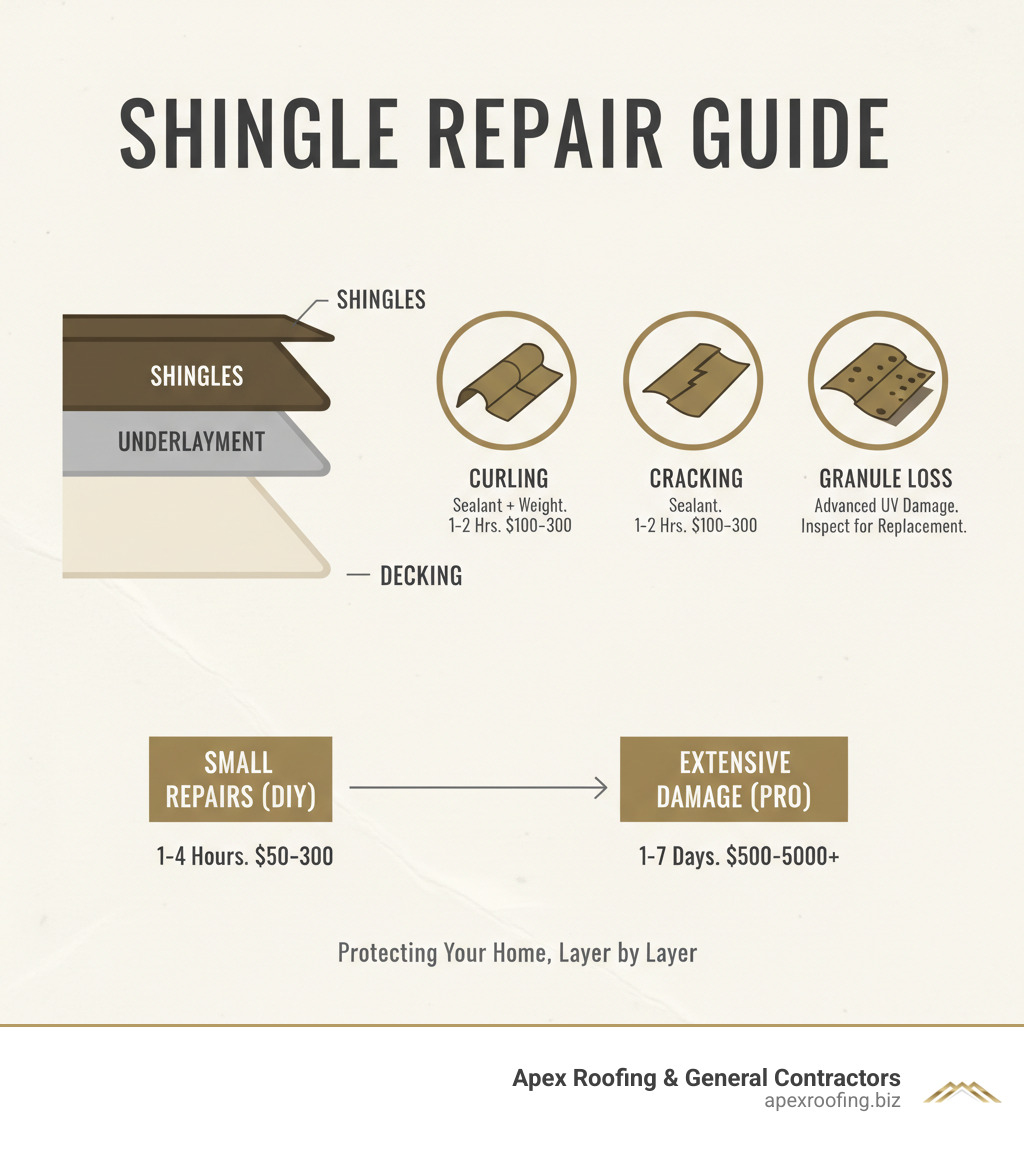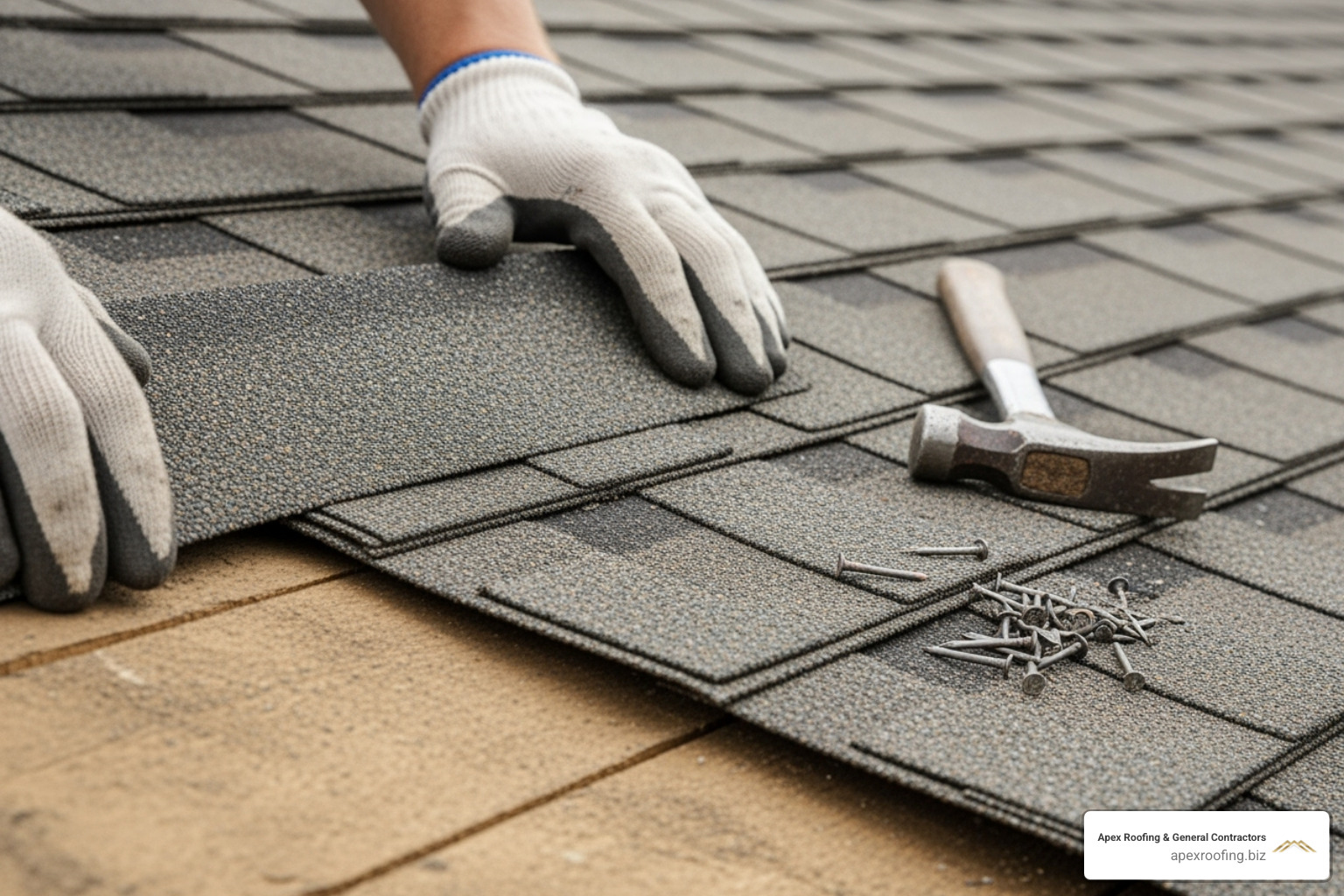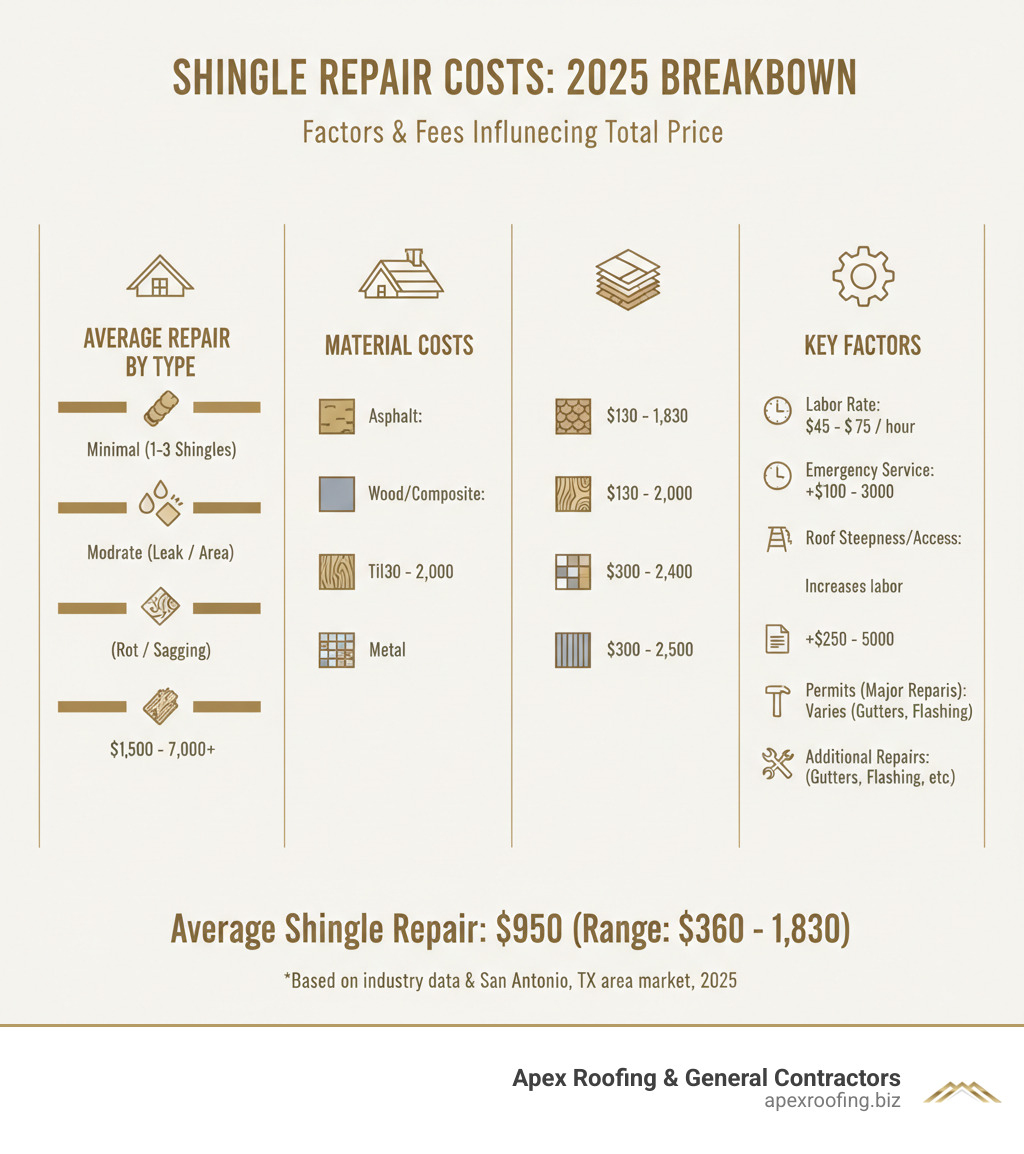Why Shingle Repair is Critical for Your Home’s Protection
Prompt shingle repair is essential for maintaining your home’s defense against the elements. A single damaged shingle can lead to water leaks, mold, and structural issues, turning a small problem into a major headache. For Texas homeowners, understanding how to address roof damage is crucial for protecting your home and your investment.
Most Common Shingle Issues:
- Missing shingles – Cost to repair: $150-$1,830
- Cracked or split shingles – Apply sealant under and over the crack
- Curled shingles – Use roofing sealant and weight for 24 hours
- Granule loss – Indicates UV damage and potential replacement needs
When to Call a Professional:
- Damage covers more than 20% of your roof
- Your roof is over 20 years old
- You see sagging areas or water damage inside
- Safety concerns with steep slopes or complex designs
While many minor repairs are manageable DIY projects, this guide will help you identify damage, gather the right tools, and decide when to call in the experts. I’m Carlos Yzaguirre, President of Apex Roofing & General Contractors. Since 2022, my team and I have seen how timely repairs extend a roof’s life, saving homeowners significant money.

Identifying Common Shingle Damage
Before starting a shingle repair, you must know what to look for. Recognizing damage early prevents minor issues from escalating. We recommend inspecting your roof twice a year—in the spring and fall—and after severe weather.
Cracked or Split Shingles
Caused by weather exposure, age, or temperature changes, cracked shingles create openings for water. If left unaddressed, this moisture can lead to rot in the underlying decking, compromise insulation, and cause interior water damage.
Curled or Buckling Shingles
Shingles that curl at the edges or buckle in the middle are clear signs of trouble. This can be caused by:
- Poor attic ventilation: Trapped heat can cook shingles from below, causing them to curl.
- Improper installation: Shingles that aren’t installed flat can buckle over time.
- Moisture absorption: Shingles can swell and buckle if they absorb too much moisture.
- Age: Older shingles lose elasticity and are more prone to curling.
Curled shingles are easily torn off by strong winds.
Missing Shingles and Granule Loss
Missing shingles are an obvious sign of damage, often caused by high winds or hail. If you find shingles in your yard after a storm, your roof needs immediate attention.
Granule loss is equally important. These sand-like granules protect asphalt shingles from UV rays. When they erode due to age or hail, the shingle deteriorates faster. You may notice granules accumulating in your gutters. Significant granule loss means your shingles are nearing the end of their lifespan. For more on hail’s effects, see our guide on What Hail Damage Looks Like on a Roof?.
Other signs of damage include:
- Blistering: Raised bubbles on the shingle surface from trapped moisture or heat.
- Wind damage: Lifted edges or creases on shingles.
- Water damage signs: Stains on interior ceilings or walls, peeling paint, or a musty attic odor indicate a compromised roof.
Ignoring these signs can lead to structural damage and mold growth. Prompt shingle repair is about safeguarding your entire home.
DIY vs. Professional Shingle Repair
When you spot damaged shingles, you must decide: handle the shingle repair yourself or call a professional? The right choice depends on the job’s complexity, your comfort level, and safety.
Here’s how DIY and professional repairs compare:
| Feature | DIY Repair | Professional Repair |
|---|---|---|
| Cost | Low (materials only) | Moderate to High (labor + materials) |
| Time | Can be time-consuming for amateurs | Efficient, quicker completion |
| Safety | High risk of injury, especially on steep roofs | Trained, experienced, proper safety gear |
| Tools | Basic tools may suffice | Specialized tools and equipment |
| Quality | Varies based on skill and experience | Consistent, high-quality, warrantied work |
| Complexity | Best for single, isolated shingles | Handles extensive damage, underlying issues, complex designs |
DIY shingle repair is best for isolated damage on an easily accessible roof. If you’re comfortable with heights and the job is small, it can be a rewarding project.
Essential Tools and Materials for DIY Repair
Gather these tools before you start:
- Hammer & Roofing Nails: For securing new shingles. Use corrosion-resistant nails (typically 1¼ inch).
- Pry Bar: To gently lift shingles without damaging them.
- Utility Knife: For cutting shingles to size.
- Caulking Gun & Roofing Sealant: To seal cracks and secure shingles.
- Sturdy Ladder: Position it on firm, level ground.
- Safety Gear: A safety harness, work gloves, and safety glasses are non-negotiable.
- Replacement Shingles: Match your existing shingles as closely as possible.
Prioritizing Safety on the Roof
Roof work is dangerous. Always prioritize safety.
- Ladder Stability: Ensure your ladder is stable and extends at least three feet above the roof edge.
- Proper Footwear: Wear non-skid shoes with good grip.
- Fall Protection: Use a fall-arrest harness, especially on steeper roofs.
- Weather: Work only in dry weather. Wet shingles are slippery, and wind is a hazard. Aim for temperatures above 40°F.
- Electrical Awareness: Stay clear of power lines.
The National Roofing Contractors Association (NRCA) offers excellent safety guidelines. If you feel unsafe, climb down and call a professional.
When to Call a Professional Roofer
Some situations demand professional expertise:
- Extensive damage: If more than 20% of your roof is damaged.
- Roof age: If your roof is approaching its 20-30 year lifespan, repairs may not be cost-effective.
- Structural issues: Sagging areas indicate problems beyond the shingles.
- Persistent leaks: Professionals can trace hard-to-find leak sources.
- Complex roofs: Steep pitches, valleys, and skylights increase risk and complexity.
- Safety concerns: No repair is worth an injury.
Professionals also provide warranties and documentation for insurance claims. If you need help finding a contractor, our guide on How Do I Find a Good Roofer Near Me? can assist. Know your limits and prioritize a safe, effective repair.
How to Perform Common Shingle Repairs
If you’ve decided a DIY approach is safe, you can tackle that shingle repair. Most homeowners can handle basic repairs with the right technique.

Step-by-Step Guide for Minor Shingle Repair (Replacing a Damaged Shingle)
Replacing a single shingle is manageable. Work on a warm, dry day when shingles are pliable.
- Break the Seal: Gently use a pry bar to lift the edges of the shingles above and around the damaged one, breaking the adhesive seal. Go slow to avoid tearing adjacent shingles.
- Remove the Nails: Lift the overlapping shingle to expose the nails holding the damaged one. Use your pry bar to carefully pull them out.
- Remove the Old Shingle: Once the nails are out, the old shingle should slide out. Inspect the decking underneath for rot or damage. If you see any, stop and call a professional.
- Position the New Shingle: Slide the new shingle into place, ensuring it aligns perfectly with its neighbors.
- Secure with Nails: Lift the overlapping shingle and drive roofing nails just below the adhesive strip, through the new shingle and into the roof decking.
- Seal the Tabs: Apply dabs of roofing cement under the tabs of the new shingle and any others where you broke the seal. Press down firmly to ensure good adhesion.
For more details, see our guide on Replacing Asphalt Shingles.
Fixing Curled or Cracked Shingles Without Replacement
For curled shingles, warm them on a sunny day to make them flexible. Apply roofing sealant underneath the curl, press the shingle down, and place a brick on top for 24 hours to help it set.
For cracked shingles, clean debris from the crack. Apply sealant underneath the crack, press it closed, and then apply another layer of sealant on top, smoothing it with a putty knife. For better blending, you can sprinkle loose shingle granules onto the wet sealant.
How Shingle Material Affects the Repair Process
Repair methods vary by shingle type. Asphalt shingle repair, as described, is the most common and DIY-friendly.
- Wood Shingles: These are more rigid. Repair often involves splitting out damaged pieces with a chisel and sliding in replacements. Matching weathered wood is also a challenge.
- Metal Shingles: These are often interlocking panels with specialized fasteners. Repairing them without proper knowledge can cause more damage and leaks.
For materials other than asphalt, or for extensive damage, we strongly recommend calling a professional.
Breaking Down the Costs and Extending Your Roof’s Life
Understanding shingle repair costs and how to extend your roof’s life can save you thousands. Smart maintenance today prevents expensive surprises tomorrow.
Understanding the Costs of Shingle Repair
The cost for shingle repair varies. Industry data shows a typical range of $360 to $1,830, but your situation could be different. A minimal repair like replacing a few shingles might cost as little as $150, while extensive work can climb to $7,000 or more.
- Material Type: Asphalt shingle repairs are most affordable ($130 – $1,830). Wood, composite, tile, or metal shingles cost more ($300 – $2,500) due to material price and specialized labor.
- Labor Rates: Expect to pay $45 to $75 per hour. Costs can increase for emergency repairs (adding $100 – $300), steep roofs, or complex designs with skylights and valleys.
- Hidden Damage: A repair might uncover rotted decking or damaged flashing, increasing the immediate cost but preventing severe structural damage later.
For homeowners in our San Antonio service area, local market conditions also influence pricing. A professional inspection is the best way to get an accurate estimate.

Preventative Maintenance to Avoid Damage
Proper maintenance can help your 20-30 year asphalt shingle roof last even longer.
- Regular Inspections: Check your roof twice a year and after storms. Use binoculars from the ground to spot missing shingles, curling, or granule loss.
- Gutter Maintenance: Clean gutters regularly. Clogged gutters cause water to back up under shingles, leading to rot.
- Tree Management: Trim branches away from your roof to prevent scraping and impact damage during storms.
- Proper Ventilation: Good attic ventilation helps dissipate heat, preventing damage from extreme Texas summers.
- Ice Dam Prevention: In cold snaps, proper ventilation and insulation help prevent ice dams. The National Weather Service provides excellent guidance on this topic.
Address small problems immediately. A quick fix on a minor issue prevents it from becoming a major headache. If a roof is nearing the end of its lifespan, replacement is often more cost-effective than continuous repairs.
Frequently Asked Questions about Shingle Repair
Here are answers to the most common questions we receive about shingle repair in Texas.
How long does a shingle repair last?
A quality shingle repair can last for several years. Its actual lifespan depends on the roof’s overall age and condition, the quality of the installation, and local weather severity. A repair on a newer roof will naturally last longer than one on an older roof that’s nearing the end of its life.
Can I repair just one shingle, or do I need to replace a whole section?
For isolated damage on a newer roof, like a single shingle blown off in a storm, replacing just that one is cost-effective. However, if multiple shingles in one area are damaged, or if the roof is over 15 years old with widespread wear, replacing a larger section is more practical and provides a more consistent look.
How do I match new shingles to my old ones?
Matching shingles is tricky due to sun fading and weathering. The best option is to use spare shingles from the original installation. If you don’t have any, take a sample of a damaged shingle to a roofing supplier. They can help identify the brand and find the closest available color. Sometimes, choosing a slightly lighter shade is better, as it will fade over time and blend in more naturally.
Conclusion
Prompt shingle repair is essential for protecting your home’s value and structural integrity. A small fix today prevents a major, costly problem tomorrow. While many homeowners can handle minor repairs, it’s crucial to know your limits. Your safety is more important than any potential savings from a DIY project.
If you’re facing extensive damage, have a complex roof, or simply don’t feel comfortable working at heights, it’s time to call a professional. Ignoring a problem or attempting an improper repair can lead to significant water damage.
For homeowners in Texas, our certified team at Apex Roofing & General Contractors is ready to help. We understand the challenges our local weather poses to roofs and offer free estimates for our expert residential roof repair solutions. Call us at (726) 727-7663 for a free inspection. A little attention will keep your roof protecting your home for years to come.




